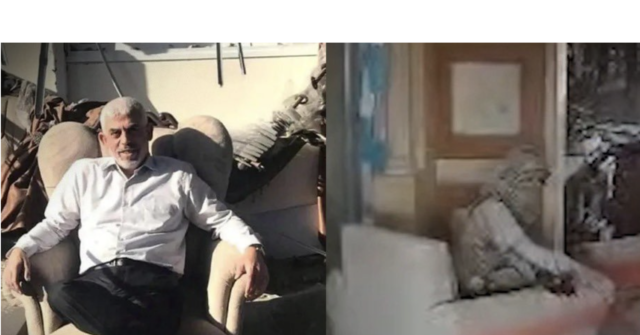In recent developments regarding the ongoing conflict between Israel and Hamas, a provocative meme shared by Colonel Avichay Adraee, the Israel Defense Forces (IDF) Arabic spokesman, has caught significant attention. The meme features Yahya Sinwar, the leader of Hamas, displayed in a dual imagery format. One side presents him in a confident posture during his peak leadership, seated in an armchair, while the other half depicts his last moments captured by an Israeli drone, illustrating a stark contrast between his commanded authority and his ultimate demise. The caption references Sinwar’s transition from power to a “miserable fate,” providing poignant commentary on the consequences of his leadership amidst the ongoing warfare. This meme reflects not just the dramatic developments in the battlefield but also the psychological warfare that accompanies this prolonged conflict.
The circumstances surrounding Sinwar’s death mark a notable moment in the conflict. He was killed not through a meticulously planned operation but rather by regular Israeli soldiers during an unexpected encounter in Gaza. This aspect underscores the chaotic nature of brutal confrontations and how leaders can swiftly be taken down amid the tumult of warfare. Following the confirmation of Sinwar’s death, Israeli Prime Minister Benjamin Netanyahu addressed the nation and the region, presenting a message infused with hope for peace while simultaneously extending a warning to Hamas. He urged remaining members of the terrorist organization to consider the lives of Israeli hostages and hinted at the possibility of a ceasefire contingent on their release.
Netanyahu’s recent public appearances, particularly a noteworthy address he delivered from Gaza while seated in an armchair, sparked discussions across social media platforms, especially within Arabic-language communities. His gesture was perceived as a subtle jab at Sinwar, reinforcing a narrative of superiority and command over the Hamas leader who had previously been thought to be operating from deep underground amidst fears of Israeli strikes. This back-and-forth on social media illustrates the crucial role that propaganda and representation play in the arena of public perception during wartime, highlighting how leaders navigate their imagery and messaging amid conflict.
The exchange of visual messaging and public declarations enhances the psychological dimensions of the ongoing conflict. In this case, the IDF effectively utilizes humor and derision through social media to depict their adversary in a diminishing light, while also symbolizing a potential turning point in military engagement against Hamas. The use of memes as a tool for communication emphasizes the contemporary dynamics of information warfare, where social media platforms serve as battlegrounds for narrative control and public engagement, influencing both local and international perspectives on the conflict.
Given his high-profile position, Sinwar’s death carries implications both for Hamas and for the broader geopolitical landscape of the region. His leadership was seen as critical in orchestrating Hamas’s military strategies against Israel, and his removal could potentially lead to a power vacuum or shifts in tactics within the group. As the conflict continues and the situation remains volatile, observers are keenly interested in how Hamas will respond to this loss and whether it will affect ongoing hostilities or incite further retaliatory measures.
Amidst the urgency of military operations and tactical responses, the comments from Netanyahu and displays such as Adraee’s meme serve to foster a narrative of resilience and eventual triumph for Israel. They echo sentiments directed toward solidarity among the Israeli populace while challenging the morale of Hamas operatives and sympathizers. These interactions highlight how symbolic representations of conflict can deeply resonate within societies engaged in prolonged strife, shaping both perceptions of victory and the human cost that accompanies warfare.

